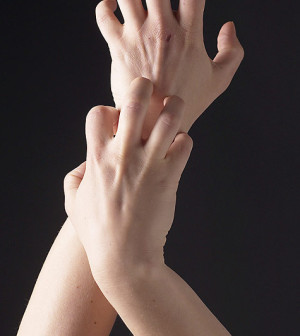- Navigating Your Midlife Crisis: Embracing New Possibilities
- City Raccoons Showing Signs of Domestication
- Mapping the Exposome: Science Broadens Focus to Environmental Disease Triggers
- One Week Less on Social Media Linked to Better Mental Health
- Your Brain Changes in Stages as You Age, Study Finds
- Some Suicide Victims Show No Typical Warning Signs, Study Finds
- ByHeart Formula Faces Lawsuits After Babies Sickened With Botulism
- Switch to Vegan Diet Could Cut Your Greenhouse Gas Emissions in Half
- Regular Bedtime Does Wonders for Blood Pressure
- Dining Alone Could Mean Worse Nutrition for Seniors
Dermatologist’s Tips for Reducing Scars After Cuts, Scrapes


During the summer, people tend to get more scrapes, cuts and scratches, which can lead to scars.
But there are a number of things you can do to reduce scarring, according to Dr. Ellen Marmur, an associate clinical professor of dermatology at the Icahn School of Medicine at Mount Sinai Hospital in New York City.
“The appearance of a scar often depends on how well your wound heals. While scars from surgery or over joints like the knees and elbows are hard to avoid, scars caused by minor cuts and scrapes can become less noticeable by properly treating your wound at home,” she said in an American Academy of Dermatology news release.
Marmur offered some tips for reducing the appearance of scars caused by minor skin injuries.
Gently wash the injury site with mild soap and water to remove debris and keep out germs. Apply petroleum jelly to keep the wound from drying out and forming a scab. Wounds with scabs take longer to heal. Petroleum jelly will also prevent a scar from getting too large, deep or itchy. If you clean the wound daily, you don’t need to use antibacterial ointments.
After cleaning the wound and applying petroleum jelly or a similar ointment, cover the wound with an adhesive bandage. Change the bandage daily to keep the wound clean while it heals. For larger scrapes, sores, burns or wounds with persistent redness, hydrogel or silicone gel sheets may be helpful, Marmur said.
If your wound requires stitches, follow your doctor’s advice on caring for the wound and when to have the stitches removed. This may help minimize the scar.
After the wound heals, apply sunscreen (SPF 30 or higher) to the site when you go outside. This may reduce red or brown discoloration and help the scar fade faster, Marmur said.
“Although no scar can be completely eliminated, most scars do fade over time. If you’re worried about the appearance of a scar, see a board-certified dermatologist. A dermatologist can answer your questions and talk about ways to make your scar less visible,” she said.
More information
The U.S. National Library of Medicine has more about scars.
Source: HealthDay
Copyright © 2025 HealthDay. All rights reserved.










